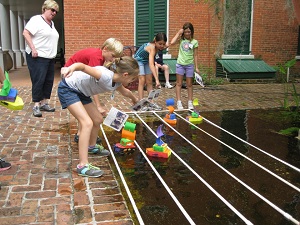
 By Jayd Buteaux, Shadows-on-the-Teche's Marketing and Programs Manager
By Jayd Buteaux, Shadows-on-the-Teche's Marketing and Programs Manager
As you walk through the gates of the Shadows-on-the-Teche, you step back in time. The bamboo quiets the noise of the city street, as you’re surrounded by the alluring gardens. A tour through the house is one of the best documented tour experiences in the country as it’s based on the site’s collection, which includes over 17,000 documents and 85% of the original family furniture. The Shadows tells the story of four generations of the Weeks family, whose fortune was made in the sugar industry utilizing enslaved labor, and whose story offers a window into New Iberia during tumultuous times in our country’s history.

1) One of the best documented tour experiences in the country.
The history of the Shadows spans four generations and about 125 years, all of which is documented. When William Weeks Hall, the last member of the family to reside in the house, donated the Shadows to the National Trust for Historic Preservation, his donation included the house and the gardens, but also original family furniture and over 17,000 documents—letters, receipts, invoices, and inventories. When touring the home today, about 85% of the furniture is original to the Weeks family. The purchase of the few pieces that are not original was based off the documentation—purchases made by the Weeks family themselves. This leads to the Shadows being one of the best documented tour experiences in the country.
The Shadows is not only the history of the Weeks family. It’s also part of the history of New Iberia. Within the Weeks Family Papers, you’ll find letters referencing the variety of people and organizations in New Iberia and the surrounding area at the time. Letters to, from, and about the town doctor. Invoices from store keepers, dressmakers, tailors, school masters, the pharmacy, the butcher in St. Martinville, and shops in New Orleans. Bouligny Plaza was basically a farmer’s market where people could buy vegetables, eggs, and chickens. Church leaders from every denomination in town made calls at the Shadows. The Weeks family did not exist in a vacuum.
There are two inventories, which catalogue everything the Weeks family owns, including the enslaved population. These inventories list first names and the kinds of work that enslaved people performed on the family plantations. Paired with the family letters, which mention specific enslaved people throughout, a picture begins to form of life here for enslaved Africans, albeit a one-sided and biased version. The Weeks family resided in the house during very pivotal parts of history—antebellum, Reconstruction, Jim Crow, and the early Civil Rights Movement. The Weeks Family Papers provide insight into what is happening in this pocket of the country during any and all of these times.


2) A trip back to the time of sugar barons.
When purchasing tickets for a tour, visitors can expect to see our introductory video, which provides essential background for the guided tour of the Shadows. Then, they cross our award-winning Main Street and pass through the gate, where they step back in time to the early twentieth century when William Weeks Hall resided in the house. As visitors tour the historic structure, they see the house as it was during the antebellum period, when Mary Conrad Weeks Moore and her family lived in the home. They hear stories, drawn from our primary documentation, of life during the nineteenth century for both the Weeks and enslaved families. Visitors are brought closer to the present day as they view Weeks Hall’s studio where a few of his paintings, easel, artist tools and infamous signed door are located.
After touring the home with the guide, visitors are welcome to wander around the grounds, beneath the canopies of 100-year-old live oak trees with Spanish moss hanging from the branches. Aspidistra lines the gravel walkways, and, along with strategically placed hedges, divides the gardens into smaller rooms. During the spring, the sweet smells from the magnolia trees and azaleas waft through the air. As you circle the back of the house, you’ll come to the gazebo where two benches allow you to rest your feet and enjoy the gorgeous view of the Bayou Teche, just as Weeks Hall did a thousand times over. The gardens are his contribution to this magnificent site.


3) From art to storytelling and games: fun happenings for the whole family.
We host a number of events throughout the year. Twice a year, in the spring and fall, we host an Arts and Crafts Fair. Over 100 vendors are spread across the grounds of the Shadows selling their homemade wares from wooden bowls to exquisite arts pieces and everything in between. There are also homemade treats—bread, fudge and honey. Tours of the house are given throughout the day.
We host a Plein Air Painting Competition during the spring. Artists from around the country travel to New Iberia for the week-long competition. Over the course of the week, participants paint all around Acadiana. We host a free Paint Out that is open to all artists, with an emphasis placed on getting students involved. There is also a free public talk given by the nationally acclaimed judge. The competition culminates in an exhibit opening, which locals are invited to attend. After the competition, the judge leads a fee-based, three-day paint workshop.
In years past, we’ve offered Evening Under the Oaks and our spring Jazz Brunch. For Evening Under the Oaks, guests spend a fall night under the Shadows’ oaks enjoying a catered dinner, drinks and music. For Jazz Brunch, visitors spend a quiet, mid-morning under the oaks, enjoying mimosas, a catered brunch and music.
In December, we host Merrymaking Season where the house is dressed for the holiday season. Garland and bows drape the balconies. Greenery and holly abound on the mantles throughout the house. The family tree in the parlor is decorated with traditional handmade ornaments. We showcase artifacts in our collection that are typically not on display. There is a nine foot Christmas tree, decorated with the ornaments from the Charley program, in Weeks Hall’s studio. The focus of the tour shifts to also include holiday traditions.
Throughout the year, we also partner with a number of organizations in New Iberia to host events including the Books Along the Teche Literary Festival, Terror-on-the-Teche and New Iberia Beneath the Balconies.
We partner with the Louisiana Sugar Cane Festival to host Farm Fest, which is the Thursday of festival week. It’s basically the kickoff to the festival. It’s a family-fun event with games scattered across the grounds of the Shadows for children of all ages. There is a farmers market where local vendors sell their wares—produce from their gardens, jams and jellies, and honey. There’s music, food and drink. Oh, and there’s the Sugarcube Sweepstakes where visitors have a chance to win gift cards and certificates for restaurants and hotels.


4) New upcoming tours and programs.
We are currently at an analysis point at the Shadows. We are beginning the strategic planning process, which will take the better part of a year. The outcome of which will be a five-year plan that outlines the programming, preservation and sustainability needs of the site.
But, as for new programming, we are hoping to offer things that attract a younger and more diverse audience. The Shadows has quite a bit of history to tell, and we are able to share only a small fraction of that information on our guided tour. We would like to offer more specialty tours as a way to tell more of the Shadows’ story and encourage local people to continue to return to the site.
The Shadows has been an anchor of New Iberia since 1834 and continues to be one today. Not only is it one of the best documented plantation homes in the country which tells the story of four generations and their city, it also offers a plethora of events for the whole family. My favorite part of working for the Shadows, so far, has been hearing others' stories about it. Everyone in town has a Shadows memory. Those memories provide insight into what people love most about the site, as well as the Shadows role in the community and people’s perception of it. Come and experience it for yourself!
If you enjoyed this blog, check out:












